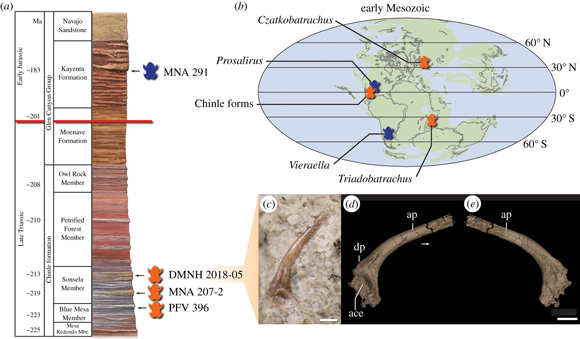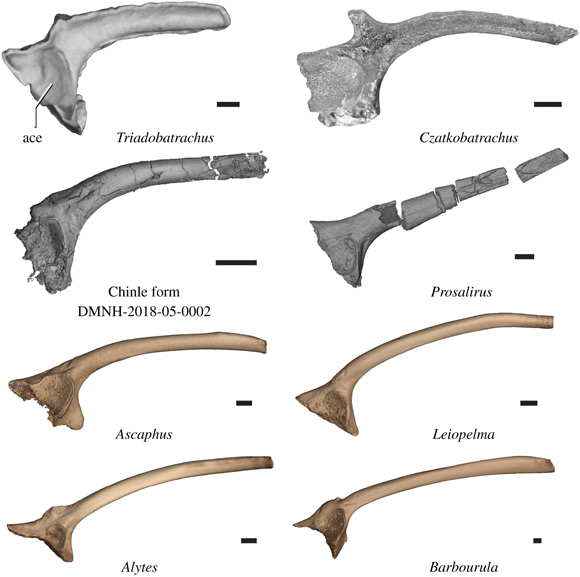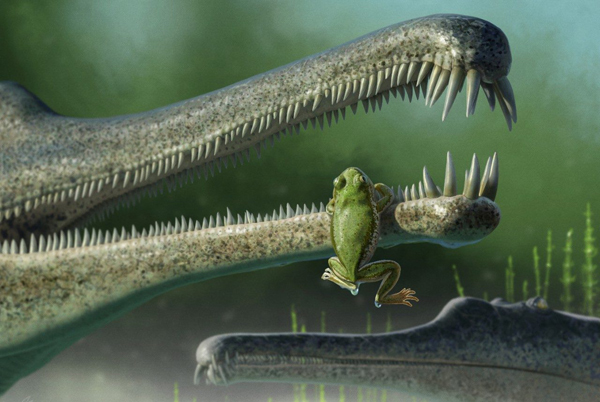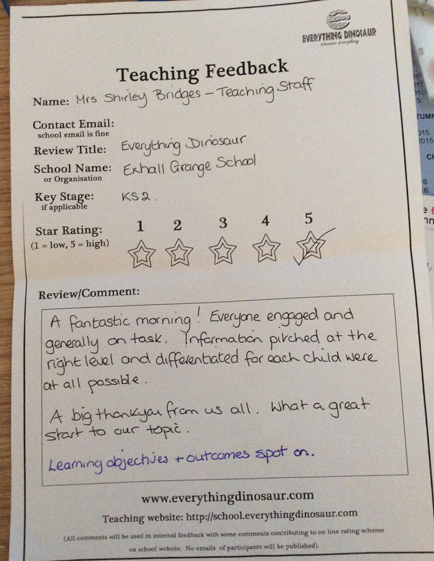New Research into Late Triassic Frogs of North America
The Earliest Equatorial Record of Frogs
Researchers including palaeontologists from the Department of Geosciences at Virginia Tech, have identified tiny fossil fragments collected from Upper Triassic deposits in Arizona that provide evidence of the oldest known frogs from North America. Although, no new genus has been erected, the scientists are confident that further study of the microfossils at the location may yield skull and jaw bones which will result in the naming of new species.
A Little Chinle Frog Has a Close Encounter with a Phytosaur
Picture credit: Andrey Atuchin
The Oldest Known Frogs from North America
The fossils are composed of several tiny pieces of hip bone, (from the ilium), they were collected last May from three separate locations within the famous Chinle Formation and they have been dated to between 223 and 213 million years ago. The bones represent the earliest equatorial record of the Salientia, the group that includes stem and crown-frogs. These tiny amphibians, little more than two centimetres in length, are not direct ancestors of modern frogs (Anura).
One of the authors of the scientific paper, published in the journal Biology Letters, Assistant Professor Michelle Stocker, stated that these fossils underscore the importance of microfossil collection, analysis and study as it helps palaeontologists to build up a more comprehensive picture of an ancient ecosystem.
New Insights into a Triassic Ecosystem
Assistant Professor Stocker explained:
“This new find highlights just how much there is still to learn about the Late Triassic ecosystem and how much we can find when we just look a little closer. We are familiar with the charismatic archosaurs from the Chinle Formation, but we know that based on other ecosystems, they should make up a small percentage of the animals that lived together. With this new focus, we are able to fill in a lot of those missing smaller components with new discoveries.”
Time-calibrated Stratigraphic and the Geographical Distribution Across Pangaea of Triassic and Jurassic Anurans

Picture credit: Biology Letters
The image above shows (a) the stratigraphic sequence indicating the three fossil examples of Chinle frogs and their relationship to the Early Jurassic Prosalirus (MNA 291) from the Kayenta Formation (Arizona), whilst (b) shows the biogeographic distribution of fossil anurans from the Jurassic and Triassic. Note, the proximity of the Late Triassic Chinle frogs to the equator. Photograph (c) shows an eyelash sized fossil ilium whilst (d) and (e) are computerised scans of the same fossil material shown in lateral and medial views. Scale bars equal 1 millimetre.
Chinle Formation Frogs – Long and Hollow Hip Bones
The fossil material gathered from extensive sieving and screen washing of sediments in order to obtain microvertebrate fossils, consists of long, hollow hip bones with the hip socket offset rather than centred, anatomical traits that are characteristic of frogs and that help to support their hoping style of locomotion. Stocker and her collaborators include fellow scientists from Virginia Tech, Arizona’s Petrified Forest National Park, and the University of Florida’s Museum of Natural History.
The Chinle frogs share more features with living frogs and Prosalirus, a genus of Early Jurassic frog found in sediments from the present-day Navajo Nation (Arizona), than to Triadobatrachus, an Early Triassic frog discovered in Madagascar.
Stocker added:
“These are the oldest frogs from near the equator. The oldest frogs overall are roughly 250 million years old from Poland [Czatkobatrachus] and Madagascar, but those specimens are from higher latitudes and are not equatorial.”
Comparing the Ilia of Stem Anurans

Picture credit: Biology Letters
Frog Evolution
Co-author Sterling Nesbitt (Virginia Tech), commented:
“Now we know that tiny frogs were present approximately 215 million years ago from North America, we may be able to find other members of the modern vertebrate communities in the Triassic Period.”
This is the first time that frog fossils have been found in sediments associated with phytosaurs and early members of the Dinosauria.
The research team hope that further work screening and washing sediments from the Chinle Formation sites, will yield more information about the tiny animals that lived alongside some of the first dinosaurs in North America.
A spokesperson from Everything Dinosaur stated:
“The sieving and screen washing methodology employed to discover the tiny hip bones and fossil material associated with Late Triassic frogs could also be used to help identify other small animals that lived in this ecosystem, animals such as salamanders, early squamates and even small mammals.”
Everything Dinosaur acknowledges the assistance of a press release from the Virginia Tech College of Science in the compilation of this article.
The scientific paper: “The Earliest Equatorial Record of Frogs from the Late Triassic of Arizona” by Michelle R. Stocker, Sterling J. Nesbitt, Ben T. Kligman, Daniel J. Paluh, Adam D. Marsh, David C. Blackburn and William G. Parker published in Biology Letters.
Visit the Everything Dinosaur website: Everything Dinosaur.



